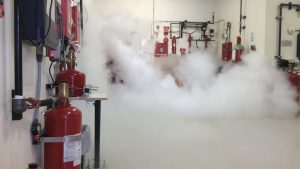
Key types of fire suppression systems include:
Sprinkler Systems: Automatic sprinkler systems are among the most common fire suppression systems. Sprinklers are strategically placed throughout the building, and when activated by heat from a fire, they release water to control or extinguish the flames. Sprinkler systems can be wet, dry, or pre-action, depending on the application.
Clean Agent Systems: Clean agent systems use environmentally friendly, gaseous agents (such as FM-200, Novec 1230, or CO2) to suppress fires by reducing oxygen levels or inhibiting the chemical reactions required for combustion. These systems are used in areas with sensitive equipment or valuable assets.
Foam Systems: Foam suppression systems combine water with foam concentrate to create a foam blanket that suppresses fires by smothering flames and cooling the fire area. Foam systems are often used for flammable liquid fires, such as those involving oil or fuel.
Carbon Dioxide (CO2) Systems: CO2 systems release carbon dioxide gas, which displaces oxygen and suppresses fires by reducing the oxygen concentration below the level required for combustion. They are used for electrical and machinery fires.
Water Mist Systems: Water mist systems disperse fine water droplets to create a mist that cools the fire and suppresses flames. These systems are effective for a variety of fire types and are often used in areas where water damage needs to be minimized.
Dry Chemical Systems: Dry chemical systems use dry chemical agents, such as potassium bicarbonate or monoammonium phosphate, to suppress fires by interrupting the chemical reaction that sustains combustion. These systems are commonly used for flammable liquid fires and electrical equipment.
Aerosol Systems: Aerosol fire suppression systems release a fine aerosol mist that suppresses fires by interfering with the combustion process. They are used in confined spaces and areas where traditional suppression agents are not suitable.
Key features and considerations for fire suppression systems:
Detection Systems: Fire suppression systems are often activated by fire detection systems, such as smoke detectors, heat detectors, or flame detectors, which detect the presence of a fire and trigger the release of the suppression agent.
Design and Installation: Fire suppression systems require careful design and installation to ensure they effectively cover the protected area and are compliant with relevant codes and standards.
Maintenance and Testing: Regular maintenance, inspections, and testing are essential to ensure the proper functioning of fire suppression systems. These systems should be tested periodically to confirm their readiness in case of a fire emergency.
Integration: Fire suppression systems can be integrated with other fire protection systems, such as fire alarms and emergency lighting, to provide a comprehensive fire safety strategy.
Fire suppression systems are a vital component of overall fire safety and emergency preparedness in buildings and facilities. Properly designed, installed, and maintained systems can significantly reduce the impact of fires and help protect lives and property.